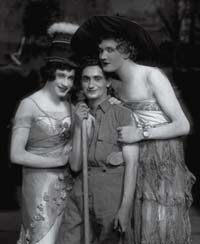Watch video from “Best Band in the Land”
Copyright Hudson West Productions
Season 1
Best Band in the Land (1940s)
Episode 2 examines how popular songs provided emotional solace and patriotic inspiration during World War II. While preparing an original patriotic song, Michael weaves in the history of 1940s big bands, USO shows, V-disks, war bond rallies, and the powerful role popular music played in boosting morale.
Web Exclusive Video
This is the Army
If the number “Mandy” from Irving Berlin’s World War II all-soldier musical revue This Is The Army were presented as a contemporary piece of transgressive high-concept Performance Art that was commenting on racial and sexual oppression and the military-industrial complex, it might well be hailed as “brilliantly provocative!” However, since it is an historical artifact that we can’t help but view through horrified contemporary sensibilities, it just seems plain bizarre. And offensive. Performers in blackface is horrifying enough to our enlightened 21st century eyes; but men in drag in blackface, in drag in blackface in stereotypical Aunt Jemimah costumes, backed up by orderly rows of swaying military men in uniform is almost too much to absorb at once. Talk about “Don’t ask, don’t tell.” So, before you hit the play button, consider yourself warned.

Max Wilk’s Army Class A Pass.
source: Max Wilk
But perhaps the strangest thing of all is that behind the scenes, This Is The Army was ahead of its time in terms of racial equality. In an era when segregation was law and custom in education, housing, and all manner of public accommodation, the cast and company of This Is The Army—a military unit—was integrated, by order of the Secretary of War. Black and white soldiers lived together, worked together, and traveled together–meaning that they all stayed in the same hotels and boarding houses as they traveled around the country. As Max Wilk, the oldest surviving member of the company explains in Episode 2, the show was the first instance of black and white integration in the armed forces. Private Max Wilk served as the advance man for the company, arranging lodging and booking theaters in places where African-Americans were not welcome, and frequently having to produce a “By order of the Secretary of War” letter to secure blocks of rooms for the entire company in the same facility.

Irving Berlin in 1918, flanked by two lovelies from his World War I revue “Yip Yip Yaphank.” In “This is the Army”, Berlin reprised his song from that show, “Oh! How I Hate to Get Up in the Morning”.
source: Photofest
Yet, while all that progressive brotherhood was happening backstage, the production onstage was conventional to a fault. Blacks and whites never even shared the stage–black performers had their own musical number, “What the Well-Dressed Man in Harlem Will Wear” which is an exercise in stereotypes, although by all accounts Irving Berlin (like all of us, a creature of his time) meant no insult. We may think today “drag” connotes homosexuality and gender confusion, but the tradition of burlesques with male actors portraying women goes back centuries. Almost every musical number in This Is The Army included men dressed as women, and apparently shocked no one. Likewise, the deplorable tradition of minstrel shows and blackface (a convention for whites and blacks) was deeply ingrained in American culture and deemed a perfectly acceptable theatrical device in 1942.
However strange or poltically incorrect it may appear to us today, This Is The Army was an admirable enterprise in its own time. It raised tons of money to support the war effort, it lifted the spirits of civilians and soldiers alike, and it was the first of many baby steps towards full integration of the armed services—which was not signed into law until War War II was over, by President Harry Truman. The past, as they say, is a foreign country, and sometimes you need a translator if you’re going to visit.
Providing support for pbs.org. Learn more
